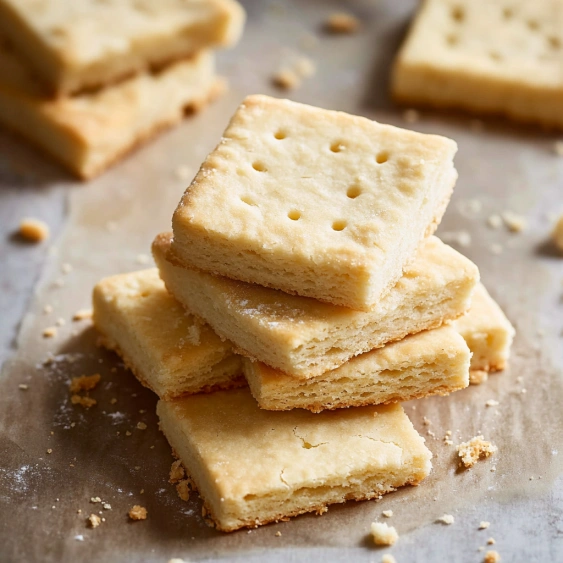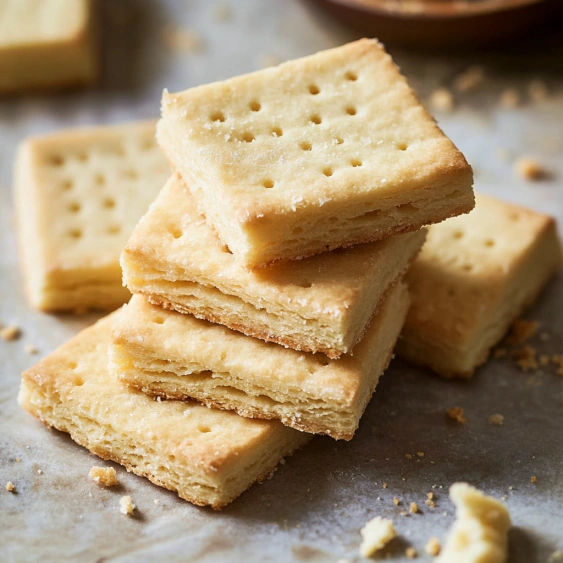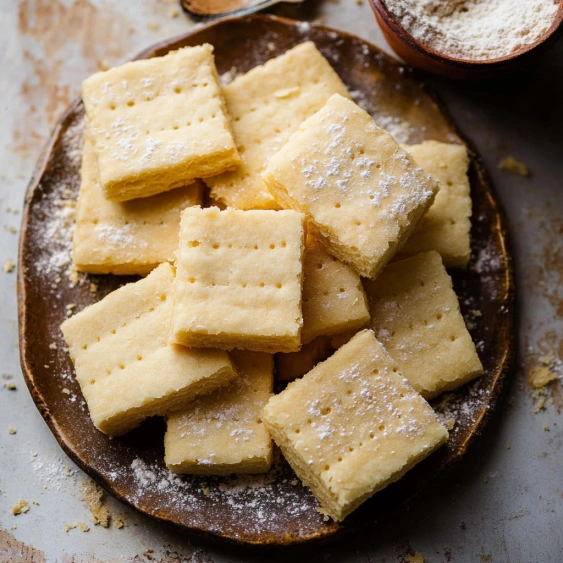 Pin it
Pin it
This simple shortbread recipe delivers perfectly buttery, crumbly biscuits with just four ingredients. I've perfected these over dozens of batches, finding the ideal butter-to-flour ratio for that signature melt-in-your-mouth texture.
These shortbread biscuits became my signature holiday gift after my Scottish grandmother taught me her technique. I still use her wooden spoon to press the dough into the pan.
Ingredients
- Plain flour: 180g provides the structure without developing too much gluten for that classic crumbly texture
- Unsalted butter: 120g chilled and cubed essential for creating those characteristic layers use the highest quality you can find
- Caster sugar: 60g plus extra for sprinkling gives just enough sweetness without overwhelming the buttery flavor
- Salt: ½ teaspoon optional but highly recommended as it enhances the flavors and balances the sweetness
Step-by-Step Instructions
- Prepare the baking surface:
- Line a large baking tray with parchment paper ensuring it lays flat in all corners. For thicker shortbread consider using a small ovenproof dish or pan which creates a more traditional Scottish-style thickness.
- Create the shortbread mixture:
- Place flour butter sugar and salt into a large mixing bowl. Use your fingertips to rub the ingredients together until they resemble fine breadcrumbs. The mixture should hold together when pressed between your fingers. Work quickly to prevent the butter from warming too much which is crucial for achieving that perfect flaky texture.
- Form and shape the dough:
- Gently press the mixture together until it forms a cohesive dough without overworking. On a lightly floured surface roll the dough to approximately 1-1.5cm thickness. Cut into rectangular fingers or your preferred shapes. Create the traditional shortbread pattern by pricking each biscuit several times with a fork about halfway through the dough. This prevents bubbling during baking and creates the classic appearance.
- Chill and prepare for baking:
- Transfer the cut biscuits to your prepared baking tray and sprinkle with additional caster sugar for a sweet sparkly finish. Refrigerate for 30 minutes to firm up the butter which is essential for maintaining shape during baking. If using a baking dish simply press the dough directly into the pan prick with a fork sprinkle with sugar and you can skip the chilling step.
- Bake to golden perfection:
- Preheat your oven to 190°C 170°C fan. Bake the shortbread for 15-20 minutes watching carefully as they approach the end of baking time. Look for a pale golden color around the edges the shortbread should not brown completely. Allow to cool for 10 minutes on the baking tray before transferring to a wire rack to cool completely which allows the texture to set properly.
 Pin it
Pin it
Butter quality makes all the difference in this recipe. I once splurged on a premium European-style butter with higher fat content for a holiday batch, and the difference was remarkable. The biscuits had an even richer flavor and that distinctive melt-in-your-mouth quality was enhanced tenfold.
Storage and Shelf Life
These shortbread biscuits will stay fresh for up to two weeks when stored in an airtight container at room temperature. The flavor actually improves slightly after the first day as the butter notes develop. For longer storage, place them in a freezer-safe container with parchment paper between layers and freeze for up to three months. Thaw at room temperature for about an hour before serving.
 Pin it
Pin it
Flavor Variations
The beauty of this basic shortbread recipe is how easily it can be customized. Add 1 tablespoon of finely chopped rosemary and lemon zest for a sophisticated savory-sweet version. For chocolate lovers, fold in 50g of mini chocolate chips or drizzle cooled biscuits with melted dark chocolate. During the holidays, I often incorporate 1 teaspoon of vanilla extract and a pinch of cinnamon or cardamom for warmth.
Traditional Scottish Connection
Authentic Scottish shortbread dates back to the 12th century when leftover bread dough was dried out in a low oven until it became crisp and sweet. By the 16th century, butter had replaced yeast, creating the rich treat we know today. Traditionally shaped in three forms rounds petticoat tails and fingers these biscuits were once considered a luxury item due to the high butter content. In Scotland, shortbread is still given as a gift on Hogmanay New Years Eve to symbolize good fortune in the coming year.
Frequently Asked Questions
- → Can I add flavors to these shortbread biscuits?
Absolutely! While the classic recipe is delicious on its own, you can add vanilla extract, lemon zest, orange zest, or lavender to the dough. For chocolate lovers, fold in mini chocolate chips or drizzle melted chocolate over the cooled biscuits.
- → Why do shortbread biscuits need to be chilled before baking?
Chilling the dough helps solidify the butter, which prevents the biscuits from spreading too much during baking. This ensures they maintain their shape and develop that characteristic crumbly, melt-in-your-mouth texture.
- → How should I store homemade shortbread biscuits?
Store cooled shortbread biscuits in an airtight container at room temperature for up to one week. For longer storage, they can be frozen for up to 3 months. Place parchment paper between layers to prevent sticking.
- → Why do you prick shortbread with a fork?
Pricking shortbread with a fork serves two important purposes: it prevents the dough from bubbling up during baking by allowing steam to escape, and it helps the heat penetrate evenly throughout the biscuit, ensuring uniform baking.
- → Can I use salted butter instead of unsalted?
Yes, you can use salted butter instead of unsalted. If doing so, simply omit the additional salt from the recipe. The result will be slightly more savory, which many people enjoy as a nice contrast to the sweetness.
- → What's the difference between shortbread fingers and rounds?
The only difference is the shape. Shortbread fingers are cut into rectangular shapes, while rounds are circular. Both varieties taste identical, but fingers are traditionally easier to dunk in tea or coffee. You can cut shortbread into any shape you prefer without affecting the taste.
